
Kids are fun to be with and are way too creative than you think. Their creativity begins from their toddler stage which is often overlooked by their parents.
Almost all kids love music and love it more if they get to make their own. It doesn’t have to be professional but just good enough for your kid to enjoy it.
Music when introduced to kids at a young age makes them active and helps them perform better in other aspects of life. But you cannot give them a grand piano or a 12 stringed guitar to begin with.
Here are a few simple options you can pick for the musician in your little munchkin.
Table of Contents
- 1. Chime Bar
- 2. Xylophone
- 3. Lollipop Drum
- 4. Tambourine
- 5. Triangle
- 6. Rhythm Sticks
- 7. Loog Guitar
- 8. Sand Blocks
- 9. Finger Cymbals
- 10. Boomwhackers
1. Chime Bar
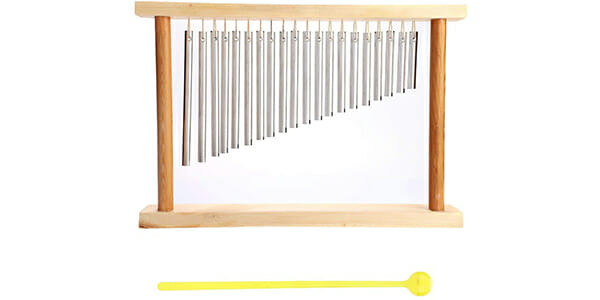
This is a percussion instrument with metal bars fixed onto their respective resonating bells. Hence the other name resonating bell. This is used for professional performances as well as in kids’ classrooms.
Each bar and bell in this instrument give out only one note making it easier to be played by your toddler. You can also give one piece of the instrument to each kid to adapt them to team-work.
The bars of the instrument are played with a mallet of suitable size improving hand-coordination of the kids. If it’s only one kid who is playing the chime bar, he is given two mallets to play the musical instrument.
Toy version of this musical instrument comes in bright colors and in sets of 8. The tuning is decent too. If your kid is under 8, you can introduce them to percussion through the toy versions.
If above 8, getting an original musical instrument is advisable as it will help them to learn playing at a professional level in the coming days.
2. Xylophone
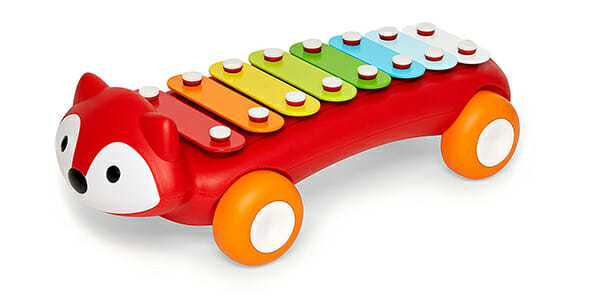
The xylophone is another percussion instrument played using a pair of mallets. You might have already been familiar with the xylophone’s popularity in kindergarten classes. It is so because of their compactness and flexibility that aid in musical development of the children.
Did we just say that the compactness of the xylophone is the reason?
That doesn’t sound convincing, does it?
Well, xylophones used for preschool are different from the professional xylophones used for concerts. Along with a reduction in the size, the octave range too decreases from that of a regular xylophone.
Lesser octave range is ideal to inculcate basic musical notes in the minds of the children without much confusion.
Usually to produce soft notes on a xylophone, hard rubber mallets are used. This may not really go well with the tender hands of kids. Therefore, wooden mallets of average weight can help in playing lighter tones.
As the kids grow up, if they are keen on learning this instrument, a professional xylophone can replace the kids’ xylophone you bought.
3. Lollipop Drum
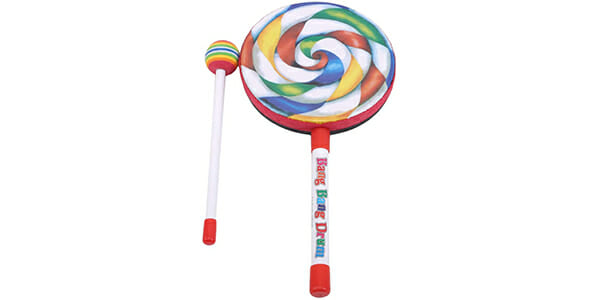
The Lollipop Drum brought to you by the company Remo is an ‘eye-candy‘ instrument ideal for kids under 6. The drum frame resembles a colored lollipop and the mallet resembles a colored sucker.
Yum!
But there is a chance of kids putting it in their mouth (it does look delicious, not your kid’s fault).
You gotta be vigilant.
Bonus, this will let you teach your kids not to put things in their mouth just ’cause they look appetizing.
The kid can play the lollipop drum either with the mallet or with his hand. This musical instrument is available in 3 sizes and you can pick the one that is the best fit for your kid’s age and physical strength.
The 6″ drum will go well with kids aged between 3 to 4, 8″ drum with kids aged 4 to 6 and 10″ drum is perfect for kids above 6. The instrument is light in weight and easy to carry around. They can take it to the classroom and bring it back home.
You can’t expect this candy-like instrument to be useful for professional performances but the kid can get familiar with the beats during pre-school.
4. Tambourine
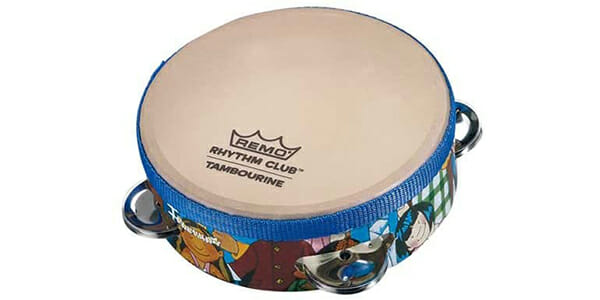
Tambourine is used along with drum kits but don’t worry, there are kids’ tambourines too.
A tambourine typically consists of a drum frame with small bells on the circumference. These small bells are called jingles or zils or cymbals and are present in sets.
Therefore, the tambourine can be played to produce sound in many ways and the kid does not get bored while exploring those options.
The models for toddlers come in smaller sizes and are usually light in weight than the regular tambourines. The frame is made of wood that is safe for kids. You can pick the one with a leather membrane instead of a plastic membrane for extra care.
Kids under 5 can sing along with their favorite songs while playing it. They can also use the tambourine to accompany their dances.
In fact, in the ancient days, dancers used tambourine and other similar instruments to elevate the grace.
Music sheets explicitly for tambourine are available for kids. If your kid knows how to read and you can spend some quality time, do get a music sheet book to help them become better at playing the tambourine.
This remains helpful to them even if they want to try other parts of the drum kit in the future.
5. Triangle
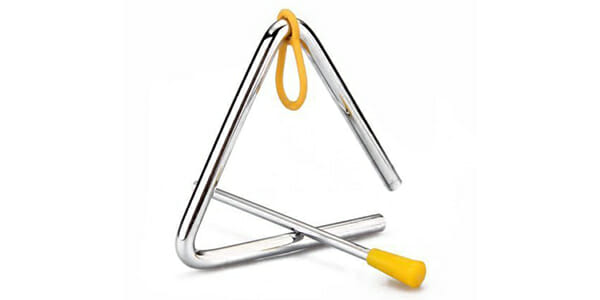
Yes, the triangle is a geometrical shape but the triangle is also a musical instrument in the shape of a triangle (except that the instrument has only two vertices).
With no strings and no membranes attached, the triangle produces sound by the vibration of the whole body. Had that one open corner not been there, vibration is impossible.
The triangle is often misunderstood as a musical instrument that requires no skill to play. But classical musicians of the olden days knew how difficult it is to master this art.
For adults playing the triangle, the written piece can get very complex involving swift movement of hands to achieve the output. Harder than it sounds!
The triangle is played with a beater called the striker. This instrument gives the kid an insight about music and particularly percussion.
Plus, the triangle is simple in looks and you can choose a vibrantly colored piece to make it exciting for your kiddo.
6. Rhythm Sticks
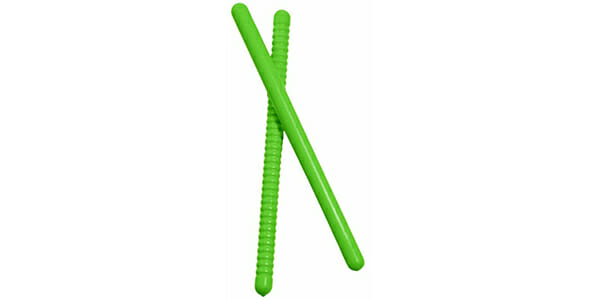
These are the best musical instrument pair you can give your toddler to start with, before they enter the complete world of music.
The rhythm sticks are simple, easy to use and flexible which is exactly what you’re looking for. Like the xylophone, rhythm sticks too have their place in the recreational period of a kindergarten class.
Rhythm sticks come in a pair and are hit with each other to go with the beat and tempo. These sticks are easy to hold and do not cause any stress on the toddler’s arms.
Did you know that rhythm sticks improve hand-eye coordination in kids which helps them to focus better?
This also makes them less clumsy as they grow up. Clumsy people! You know what we mean.
Pick songs that are within 6 lines for the kids. Play a song and let the kids listen to it. Show them how to play the sticks at each beat.
It is ideal to begin with songs of a moderate tempo. Make sure you teach them not to hit themselves or others with the sticks.
7. Loog Guitar
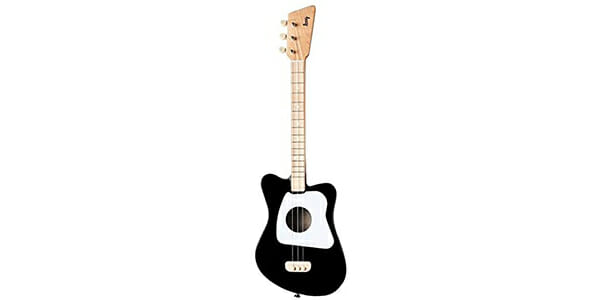
Loog Guitars is a brand of guitars that are aimed at transforming toddlers into guitarists.
The Loog guitar is a 3 stringed guitar that dissolves complex chords to simple three note chords.
This guitar is similar to the regular guitar used by adults and therefore, the Loog Guitar is not a mere toy. Three string system makes it easier for kids to adapt to the conventional 6 stringed guitar as they grow up.
The method of tuning, the tonal order and the fretboard is exactly like the normal guitars you see everyday except that all of it is made possible by just 3 strings.
The material used in the manufacturing of the guitar and its strings is suitable for kids as the finger cuts are minimal. Many parents fear finger cuts to let their kids try guitar at a young age.
Loog guitar offers their customers (well, our kids who are using their guitar) access to their app which acts as a tutor and teaches the toddler how to strum, play chords and songs.
You don’t have to worry about finding a guitar class for your kid. Get your kid a Loog guitar, log them into the app and watch them learn to slay it.
8. Sand Blocks
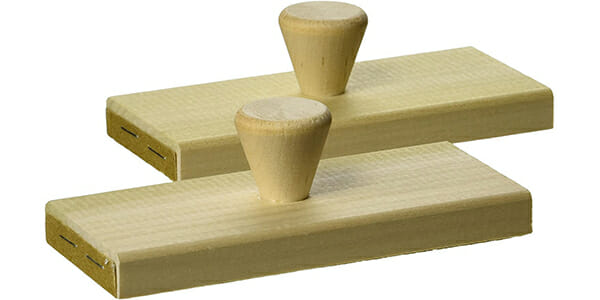
Sand blocks are kid-friendly percussion instruments and are perfect for beginners, toddlers here.
Older kids are encouraged to make their own sand blocks in the crafts class. But, you can’t do that to toddlers. Here is what you can offer them.
Sand blocks are available from many lines of toy-makers. Sand blocks are played two ways, by striking them to each other and by dragging against each other. The inner portion of the sand blocks has an abrasive surface which is why the dragging motion works.
When commercially bought, the sand blocks come with a handle to hold while playing them. There are blocks available without a handle too but you don’t want your toddler to accidentally slip their finger into the blocks while playing.
Sand blocks with thinner sides are easier for the children than those with thicker sides. Remember that the sand blocks need to be replaced when the inner abrasive surface completely wears off.
9. Finger Cymbals
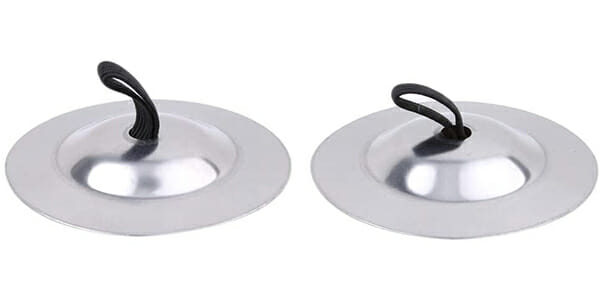
Finger cymbals are simple yet interesting musical instruments that were famous among adult dancers, particularly belly dancers, since ages. Dancers tied them to their fingers with the help of threads and rubber ties and moved their fingers to produce a suitable music for their dance.
Though there was a separate team of musicians to deal with the music arrangement, finger cymbals added extra jingle that doubled the beauty of the dance.
Finger cymbals are professionally known as zills which are sometimes added to a drum frame to make a tambourine. Yep, the same tambourine we talked about in this article.
They are made of light-weighing brass or bronze as the finger has to take the weight when these cymbals are used individually.
If you’re considering buying finger cymbals for a group of kids, pick the ones that are less in diameter. Smaller cymbals when used in a large number make a soothing sound. For one or two kids, large finger cymbals will bring the tone.
10. Boomwhackers
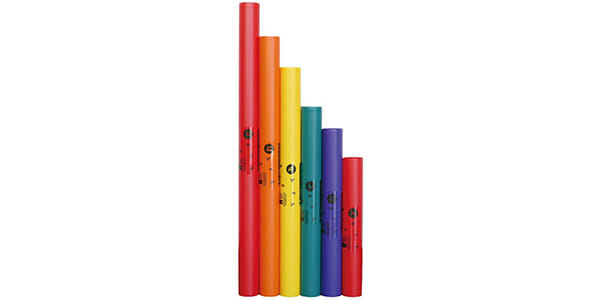
These colorful tubes do not seem like a musical instrument at first sight.
Boomwhackers are light in weight and colorful (even those boomwhackers for adults are brightly colored too, the kid in us needs that sometimes) and add a special percussion sound to a performance.
Boomwhackers take things to a boom no matter to which surface you hit them to. Kids behaviorally have this tendency to beat things in their hands to the surface they get their eyes on. Boomwhackers are what you gotta give them.
The kid can beat two boomwhackers to each other, or one tube to a wall or place tubes in a line as in a xylophone and hit them with a mallet, the possibilities are many and enough for his/her curious mind. Boomwhackers are shown to be effective in evoking the creativity in children with special needs because of their versatility.
Conclusion
We hope this list helped you to find what you’re looking for.
Whatever your kid begins with, don’t be disappointed if they can’t do it well and remember no to discourage them if they dream about going to a professional musician’s standards.
Let their little creative minds bloom without a break!

